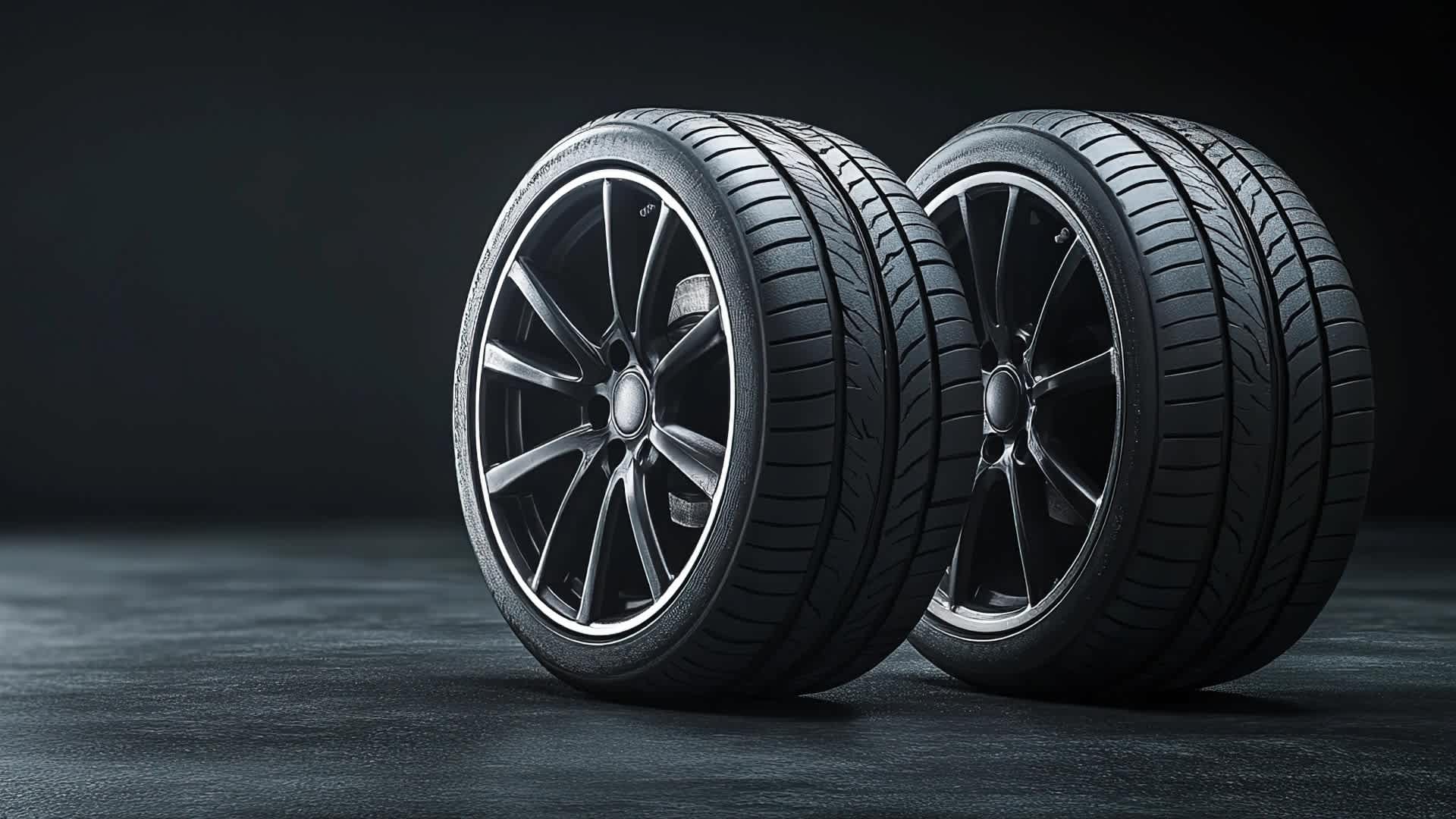Tire News & Information
Free shipping
Best price guarantee
Special pricing
Financing with Resolve
Easy returns

Your tires perform an incredible balancing act every time you drive. They must handle the forces of acceleration, braking, and turning, often simultaneously, while maintaining contact with just a palm-sized patch of rubber on the road.
Understanding how tires manage these competing demands reveals why your vehicle behaves the way it does during different driving situations. The science behind tire dynamics explains everything from why your car understeers in a fast corner to why you can't brake as hard while turning.
At the heart of this complex interaction lies a simple concept: the circle of forces. This fundamental principle governs how much grip your tires can provide and how that grip gets distributed between the various demands you place on them.
What Is the Circle of Forces in Tire Dynamics?
The circle of forces, also known as the friction circle or traction circle, provides a visual representation of your tire's maximum grip capacity in all directions. Picture a circle drawn around your tire: this boundary represents the absolute limit of force your tire can generate before it begins to slip. Inside this circle lies every possible combination of accelerating, braking, and turning forces your tire can handle simultaneously.
Think of this circle as your tire's performance envelope. The horizontal axis represents lateral forces (turning left or right), while the vertical axis shows longitudinal forces (accelerating forward or braking). Any point within the circle indicates available grip; reaching the circle's edge means your tire has reached its maximum capability. Exceed this boundary, and your tire loses traction, resulting in wheelspin, lockup, or sliding.
Key Components
The friction circle consists of four primary zones that correspond to your driving inputs:
- Forward acceleration zone: The upper portion of the circle represents the maximum force available for speeding up
- Braking zone: The lower section shows how much force your tires can generate when slowing down
- Left and right turning zones: The sides indicate maximum cornering forces in each direction
- Combined zones: The areas between represent what happens when you combine inputs, like braking while turning
Understanding these zones helps explain why certain driving techniques work. Trail braking, for instance, utilizes the principle that as you reduce braking force, you free up grip for turning. The total force always remains within the circle; you simply redistribute it based on your inputs. This redistribution happens constantly as you drive, with your tires automatically adjusting their force generation to match your demands, up to their physical limits.
The size of your friction circle depends on multiple factors: tire compound, road surface, temperature, and vehicle weight all play crucial roles. A high-performance summer tire on dry pavement creates a large circle with plenty of available grip. That same tire on wet roads sees its circle shrink dramatically. Winter conditions can reduce the circle to a fraction of its dry-weather size, which explains why everything from accelerating to stopping takes longer on snow and ice.
How Do Tires Generate Grip While Turning?
The Grip Generation Process
Tires create grip through a complex interaction of mechanical forces. When you steer, your tires rotate slightly out of the travel direction; this rotation creates a slip angle. This angle causes the tire's contact patch to change shape, engaging the rubber's elasticity.
This alteration generates lateral forces needed to guide the vehicle through turns. The contact area, where the tire touches the road, is vital in maintaining this grip. It constantly adapts to provide the stability necessary for smooth navigation.
Understanding Slip Angle
Slip angle defines the variance between the tire's intended direction and its actual path. Maintaining a moderate slip angle optimizes grip, enabling efficient tire performance during turns. This balance allows the tire to manage forces without losing traction.
Excessive slip angles lead to reduced grip as the tire begins to skid. Skilled drivers leverage their knowledge of slip angles to control speed effectively, ensuring the tire stays within its optimal performance range. This balance is key to achieving precise and controlled handling.
What Factors Affect Tire Performance During Cornering?

Tire-Related Factors
Tire performance during cornering is influenced by several critical elements. Tire pressure determines the shape and size of the contact patch. Proper inflation ensures optimal contact with the road, maximizing stability and control. Incorrect pressure can lead to reduced traction and uneven tire wear.
Tire composition affects how the rubber interacts with the road. As tires warm up, the rubber becomes more flexible, enhancing grip. However, excessive heat can compromise the material's integrity, affecting performance.
Tire dimensions affect cornering dynamics. Wider tires generally provide a larger surface area, which can improve grip. It's essential to match tire size to the vehicle's design to maintain handling balance. Tread design also impacts traction by effectively channeling water away, maintaining road contact, especially in wet conditions.
External Factors
External conditions significantly impact tire performance. Road texture, whether smooth or rough, affects grip levels. Smooth, dry roads offer ideal conditions, while wet or uneven surfaces can challenge traction.
Vehicle weight balance is crucial for even tire force distribution. Proper weight distribution ensures no single tire is overloaded, promoting uniform performance and wear. Suspension alignment is vital in keeping tires connected to the road, especially on uneven terrain, ensuring consistent traction and stability.
Velocity influences how tires function during cornering. At higher speeds, the forces on the tires increase, reducing the available grip for safe turning. Managing speed helps drivers maintain control and ensure tires operate within their optimal range.
What Is the Relationship Between Tire Slip and Grip?
The Slip Ratio Concept
The slip ratio measures the difference between the tire's rotational speed and the vehicle's speed. When the slip ratio is 0, the tire rolls without slipping; a ratio of 1.0 indicates a fully locked tire. Achieving optimal performance involves maintaining a slip ratio where tires generate maximum braking and acceleration force, typically between 15-30%.
Balancing Forces
Efficient driving involves a careful distribution of forces acting on the tires. It's crucial to manage the available grip between turning, braking, and accelerating. When a significant portion of the tire’s grip gets allocated to cornering, less remains for other maneuvers.
By understanding how to shift forces smoothly, drivers can enhance their control over the vehicle. Techniques that allow for a gradual transition between braking and turning help maximize tire performance. This knowledge enables more precise handling, ensuring safety and stability during complex driving scenarios.
How Can Understanding Tire Dynamics Improve Driving Safety?
Practical Applications for Everyday Driving
Grasping tire dynamics helps drivers maintain control and enhance safety. By understanding tire capabilities, you ensure safe performance within those limits. This knowledge helps you smoothly transition between maneuvers, improving vehicle stability.
Weight balance significantly impacts handling during driving. Sudden actions can disrupt balance, leading to instability. Awareness of weight distribution enables informed steering and braking, helping maintain control. Detecting early signs, like tire noise, warns you of approaching grip limits, prompting timely adjustments.
Comprehending tire forces emphasizes the importance of regular maintenance. Routine inspections and adjustments keep tires functioning optimally, directly influencing safety. Well-maintained tires deliver consistent performance, ensuring reliability under various conditions.
Emergency Situations
In emergencies, tire dynamics understanding is crucial. When braking abruptly, keeping the wheels aligned optimizes stopping efficiency and minimizes the risk of skidding. Knowing how to balance grip between turning and braking aids precise obstacle navigation.
Feedback through the steering wheel, known as self-aligning torque, helps detect traction regain. This sensory input guides your actions, ensuring swift, accurate responses during critical times. Armed with these insights, drivers can confidently handle challenging situations and maintain control when it counts most.
Reading Your Tires Through the Friction Circle
What the Circle Tells You
The friction circle illustrates the tire's capability to handle various driving forces. Ideally, a round circle signifies equal performance in all directions. In practice, many tires form an ellipse, often with superior braking compared to acceleration. The circle's dimensions depend on factors like tire quality, condition, and the road surface. Performance tires generally feature larger tread blocks, offering enhanced grip and adaptability compared to economy models.
Using This Knowledge
Grasping your tire's friction circle enhances driving efficiency. Smooth, controlled inputs keep the vehicle within the circle, enhancing safety and stability. Aggressive maneuvers approach the circle's edge, risking traction loss. Weather can dramatically reduce the circle's size, necessitating cautious driving to maintain control and grip.
Maximizing Your Tire Performance
Maintenance for Optimal Grip
Consistent tire care is essential for top performance. Regularly inspect your tires for proper inflation. This ensures they maintain the best possible contact with the road, optimizing safety and handling. Under-inflated tires can lead to poor performance and increased wear.
To keep your tires functioning evenly, schedule rotations based on your vehicle's mileage. This practice balances wear across all tires, enhancing stability. Observing tread depth is crucial; ensuring sufficient tread prevents loss of traction, especially in challenging driving conditions. Consider replacing tires in complete sets for a harmonious driving experience.
Driving Techniques
Adopting efficient driving habits can significantly enhance tire longevity. Gradually applying inputs allows your tires to manage forces effectively, ensuring smooth vehicle operation. Anticipating the road ahead helps you avoid abrupt maneuvers, reducing stress on your tires.
In wet weather, adjust your speed to maintain control and ensure your tires stay engaged with the road surface. This adjustment is vital to prevent slipping. Paying attention to how your vehicle responds through the steering wheel provides insights into how your tires interact with the road, aiding precise, safe driving.
Common Misconceptions About Tire Dynamics
Myths vs Reality
Understanding tire dynamics dispels several misconceptions:
- Myth: Wider tires automatically enhance performance. Wider tires can improve contact with the road, but they demand precise suspension tuning to avoid negatively affecting vehicle handling.
- Myth: Higher tire pressure equals better performance. Excessive pressure reduces the tire's contact area, leading to diminished grip. Proper inflation ensures balanced performance and safety.
- Myth: All-season tires excel in every condition. Designed for versatility, they perform adequately in various situations but lack specialization for extreme conditions. Specific tire types provide optimal performance when necessary.
- Myth: Racing tires are necessary for safety. Quality street tires deliver ample grip for everyday driving scenarios. Racing tires are engineered for track conditions, not the diverse challenges of daily roads.
Understanding Your Limits
Recognizing your tires' capabilities enhances driving proficiency:
- Grip potential: Street tires offer substantial grip suited for typical driving needs, often beyond what most drivers utilize.
- Temperature effects: Cold tires need careful handling until they reach their optimal performance temperature. Gradual warming is essential.
- Environmental influences: Even top-tier tires can't defy natural conditions. Adapting to weather variations ensures continued safety.
- Feedback awareness: Tires constantly provide steering feedback, helping make informed driving adjustments.
Understanding the circle of forces transforms how you approach every turn, stop, and acceleration, making you a safer and more confident driver. Your tires work within precise physical limits, and recognizing these boundaries helps you maximize their performance while extending their lifespan. When you're ready to put this knowledge into practice with new tires, we make it easy to shop for tires online and find the best deals that match your driving needs and budget.
Ready to find the perfect tires?
Search By